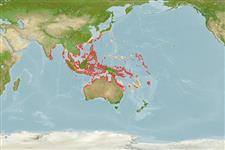Common names from other countries
Classification / Names / Names
Nomi Comuni | Sinonimi | Catalog of Fishes (gen., sp.) | ITIS | CoL | WoRMS
Environment: milieu / climate zone / depth range / distribution range
Ecologia
Associati a barriera corallina; distribuzione batimetrica 1 - 15 m (Ref. 100937). Tropical; 36°N - 27°S, 34°E - 180°E (Ref. 847)
Indo-Pacific.
Length at first maturity / Size / Peso / Age
Maturity: Lm ? range ? - ? cm Max length : 100.0 cm WD maschio/sesso non determinato; (Ref. 269)
Colonies form large plates covered with thin, high collines that form radiating valleys. The plates may be more than 1 m in diameter while the colonies may reach several centimeters in height. Corallites are widely spaced with septocostae continuous between them (Ref. 269). Zooxanthelate (Ref. 19).
Maximum depth from Ref. 98471. Common from below the reef flat to the limit of coral growth (Ref. 269). Also in lower reef slopes and turbid water (Ref. 98471). Has high bleaching level and high estimated mortality in Palau (Ref. 66144).
Life cycle and mating behavior
Maturità | Riproduzione | Deposizione | Uova | Fecundity | Larve
Hermaphroditic (Ref. 113712). Mature gametes are shed into the coelenteron and spawned through the mouth. Life cycle: The zygote develops into a planktonic planula larva. Metamorphosis begins with early morphogenesis of tentacles, septa and pharynx before larval settlement on the aboral end (Ref. 833).
Hodgson, G. 1998. (Ref. 269)
IUCN Red List Status (Ref. 130435)
CITES status (Ref. 108899)
Not Evaluated
Human uses
| FishSource |
Strumenti
Fonti Internet
Estimates based on models
Preferred temperature
(Ref.
115969): 25.2 - 29.3, mean 28.7 (based on 2397 cells).
Vulnerability
High vulnerability (60 of 100).
Price category
Unknown.
